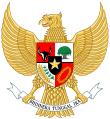|
Provisional Constitution of 1950
The Provisional Constitution of 1950 (Indonesian: Undang-Undang Dasar Sementara Republik Indonesia 1950, UUDS 1950) replaced the Federal Constitution of 1949 when Indonesia unilaterally withdrew from the union with the Netherlands agreed at the Round Table Conference and returned to being a unitary state. It came into force on 17 August 1950. It was abrogated on 5 July 1959 when President Sukarno issued a decree dissolving the Constitutional Assembly and restoring the 1945 Constitution of Indonesia. BackgroundOn 27 December 1949, following the handover of sovereignty from the Netherlands to the United States of Indonesia (RUSI), the Federal Constitution of 1949 replaced the 1945 Constitution of Indonesia. However over the next few months, there appeared a groundswell of public opinion for a return to a unitary state. By early May 1950, this had become the major priority for the RUSI cabinet led by Prime Minister Mohammad Hatta. On 19 May 1950, Hatta (representing the RUSI and the states of East Indonesia and East Sumatra) and the prime minister of the (constituent) Republic of Indonesia Abdul Halim agreed on a Joint RUSI-Republic of Indonesia Charter, which contained the following points:[2]
The two governments further agreed that this provisional constitution would be submitted to both states' parliaments for approval (but not amendment). If that was obtained, a joint session of both parliaments would be held, at which the president would formally inaugurate the unitary state. Committee for the Preparation of the Unitary StateThis committee was formally established immediately after the 19 May agreement. It had 14 members, with seven appointed by each government. It was chaired jointly by the RUSI justice minister Soepomo and the Indonesian Republic's prime minister Abdul Halim. Hatta and Abdul Halim had previously agreed that all the members of the RUSI House of Representatives as well as the republic's legislature would be members of the unicameral parliament, with other members to be appointed by the president. The committee eventually decided that in addition, the members of the RUSI senate and the Supreme Advisory Council of the Republic would also be members, resulting in a 236-member house. The committee also decided that Jakarta would be the capital of the state and that the nation would be divided into 10 provinces and two special regions (Greater Jakarta and Yogyakarta). After two months of deliberations, the committee agreed on a draft constitution, which after some minor changes, was approved by both governments on 20 July. Both parliaments approved it on 14 August, three days ahead of the Independence Day anniversary deadline.[3] Provisions of the ConstitutionLike its predecessor, this constitution would be provisional and would stipulate that a constitutional assembly would produce a definitive document. It provided for a unicameral parliamentary form of government with a cabinet and prime minister held responsible to the parliament and for a President but with no real executive powers. With a total of 146 articles, the constitution was divided into six main sections:[4]
Key provisions included:
Abrogation of the ConstitutionIn 1955 elections were held for the Constitutional Assembly, which was tasked with drawing up a permanent constitution. However, after much wrangling, it failed to agree, with the principal issue being the role of Islam in the new state. In July 1958, army chief-of-staff Abdul Haris Nasution suggested returning to the 1945 Constitution. The army organised demonstrations in favour of this, and the idea gained popularity with a number of political parties. After it had failed to obtain the necessary two-thirds majority for such a return, on 5 July, President Sukarno issued a decree dissolving it and restoring the 1945 Constitution of Indonesia.[5] Notes
References
External links |
|||||||||||||||||||||||||||||||

